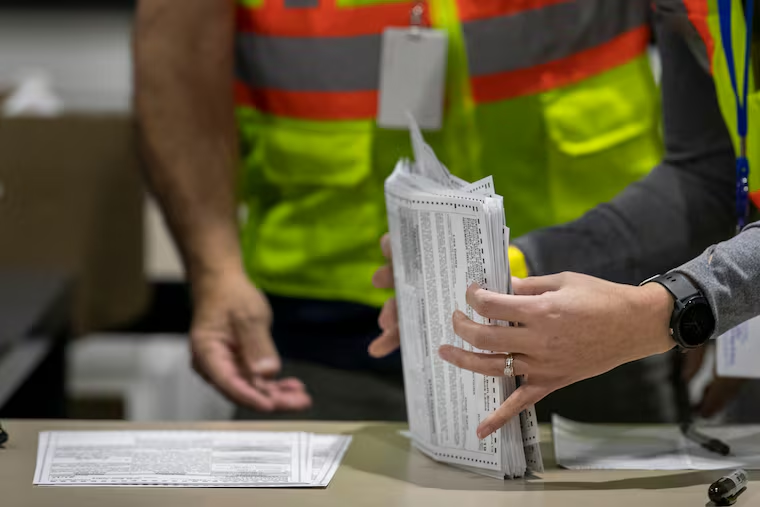Only 10,000 Pa. mail ballots arrived after Election Day — far too few to change the result if thrown out
While there are tens of thousands of remaining votes, many of those ballots are not being challenged in any way and will be counted.

The vote counting continues.
Even after races are called, even after the world’s eyes turn from Pennsylvania, workers are continuing to count ballots.
Many of the remaining ballots are the slowest or most difficult to count because they have various issues that require elections officials to review them more closely. Others, such as provisional ballots, require checking voters’ eligibility and manually checking whether they had already voted.
While there are tens of thousands of remaining votes — including about 10,000 that arrived during a three-day post-Election Day grace period that Republicans are challenging in court — many of the remaining ballots are not being challenged in any way and will be counted. And the remaining votes being challenged, even if all of them are thrown out, would not reverse Joe Biden’s victory in Pennsylvania.
Biden had 47,600 more of the already-counted votes than Trump did as of Wednesday.
The remaining ballots primarily fall into one of four categories.
Ballots received between 8 p.m. on Election Day and 5 p.m. Friday
While state law requires mail ballots to be received by county elections officials by 8 p.m. on Election Day, the Pennsylvania Supreme Court extended that deadline in September because of mail delivery delays and the pandemic.
That extension allowed ballots to be counted if they were received by mail by 5 p.m. last Friday and either postmarked by Election Day or have missing or illegible postmarks.
Republicans have repeatedly sought to block or overturn that ruling, so Secretary of State Kathy Boockvar ordered counties to keep those ballots separated from ballots received by Election Day.
There are about 10,000 ballots that arrived in the grace period after Election Day, the Pennsylvania Department of State said late Tuesday.
At Republicans’ urging, U.S. Supreme Court Justice Samuel Alito — who oversees emergency matters arising from Pennsylvania for the court — ordered the counties last week to keep the ballots separated, which they were already doing because of Boockvar’s guidance. But Alito stopped short of granting Republicans' request that he order those ballots not be counted at all while the high court considers whether to take up the case of overturning the three-day extension.
In the meantime, Boockvar told the court last week, counties were not including their separate tallies of votes that arrived during that period in the overall tally they had reported. Even if the court were to intervene and throw out those ballots at a future date, they alone aren’t enough to change the outcome of the race.
And legal experts are widely skeptical that even if the Supreme Court were to intervene and overturn the grace period for future elections, they would also throw out ballots submitted by voters just following the guidance of election administrators at the time.
Ballots with minor to moderate issues that require manual review
Ballots with no clear problems are quickly counted, but some are always set aside for manual review.
In some cases, the county board of elections needs to decide whether to accept a ballot with an issue, such as an envelope that the voter signed in the wrong spot. Or, say, a ballot for one county that was placed in a drop box in another county. Some ballots have problems that can still be fixed by voters: Philadelphia released a list of more than 2,000 voters Wednesday whose ballots were received but whose identity cannot be verified. If those voters provide identification by Thursday, their ballots will be accepted and counted.
In other cases, ballots are literally messy, such as stained, smeared, or damaged, and workers need to carefully copy them onto new ballots so they can be scanned and counted.
It’s unclear how many such ballots remain statewide.
Ballots from overseas and military voters that were received through Tuesday
Overseas and military voters have their votes counted if they are received by one week after Election Day and postmarked by the day before Election Day.
The Department of State said 27,650 of 37,239 such voters’ ballots “have been returned and counted so far.”
Provisional ballots cast at polling places on Election Day
Provisional ballots are back-up paper ballots handed out at polling places when poll workers can’t confirm whether a vote should be counted. Those ballots are set aside and reviewed later. Usually there are very few provisional ballots, mostly for issues such as first-time voters who don’t bring identification or people who can’t be found in the poll books.
This year, a large number of provisional ballots came from voters who requested mail ballots and then went to vote in person. Voters who didn’t hand over their mail ballots to be voided had to use provisional ballots so elections officials could check later whether they already voted by mail, preventing double voting.
Reviewing provisional ballots is a time-consuming process, with workers looking up voter information to determine whether to count the votes. And already, the Trump campaign has filed challenges seeking to throw out more than 15,000 provisional ballots from Philadelphia and its suburbs for defects like missing signatures or incorrect dates.
There are about 94,000 provisional ballots statewide, the Department of State said.
“The counties have done an impressive job counting a record number of mail ballots and now are canvassing the provisional ballots, each of which must be considered individually,” Boockvar said in a statement.
-Staff writer Jeremy Roebuck contributed to this article.